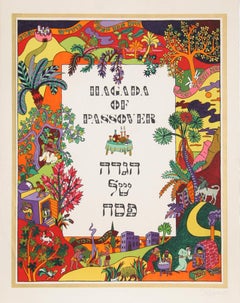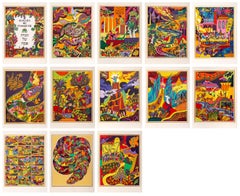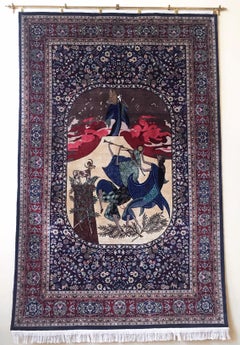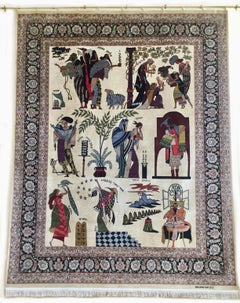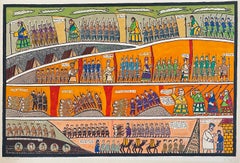Shlomo Katz Art
Israeli, Polish, 1937-1992
Shlomo Katz was born 1937 in Lodz, Poland and he immigrated to Palestine in 1945 at the age of eight. He went to school at Kibbutz Mishmar Ha'emek, and his teachers noticed his artistic ability from the beginning. He then went to Paris to pursue art where he studied at the Ecole de Beaux Arts. It was there that he developed his original technique of oil painting on a gilded metal surface. This gold surface and his rich colors resemble oriental miniatures and medieval icons.
Katz’s serigraphs became the ultimate in modern printmaking and in 1985 he was commissioned by the Falcon Foundation to design 9 large pieces of art for the chapel at the United States Air Force Academy in Colorado Springs, now considered a National Treasure. Katz's works are featured in galleries and museums in Israel, Australia, France, Hungary, United States, and England.
(Biography provided by Reeves Art + Design)
to
4
2
2
2
2
2
Haggadah of Passover, Portfolio of Lithographs by Shlomo Katz 1978
By Shlomo Katz
Located in Long Island City, NY
Artist: Shlomo Katz, Polish/Israeli (1937 - 1992)
Title: Hagada of Passover Portfolio
Year: 1978
Medium: Portfolio of 12 Lithographs (plus 2 more), each signed in pencil
Edition: 350...
Category
1970s Folk Art Shlomo Katz Art
Materials
Lithograph
Haggadah of Passover, Suite of 13 Lithographs by Shlomo Katz 1978
By Shlomo Katz
Located in Long Island City, NY
Artist: Shlomo Katz, Polish/Israeli (1937 - 1992)
Date: 1978
Set of 13 Lithographs, signed in pencil
Edition size: 350
Image Size: 23 x 18 inches
Size: 29 x 21 in. (73.66 x 53.34 cm)
Category
1970s Folk Art Shlomo Katz Art
Materials
Lithograph
Moses and the Ten Commandments (Passover), Large Tapestry Rug by Shlomo Katz
By Shlomo Katz
Located in Long Island City, NY
Artist: after Shlomo Katz, Polish/Israeli (1937 - 1992)
Title: Moses and the Ten Commandments (Passover)
Year: 2000
Medium: Woolen Carpet Tapestry
Size: 84 x 54 in. (213.36 x 137.16 cm)
Category
Early 2000s Expressionist Shlomo Katz Art
Materials
Tapestry, Wool
Who Knows One (Passover), Large Tapestry Rug by Shlomo Katz
By Shlomo Katz
Located in Long Island City, NY
Artist: after Shlomo Katz, Polish/Israeli (1937 - 1992)
Title: Who Knows One (Passover)
Year: 2000
Medium: Woolen Carpet Tapestry, signature in the cache
Size: 120 x 95 in. (304.8 x ...
Category
Early 2000s Expressionist Shlomo Katz Art
Materials
Tapestry, Wool
Related Items
Israeli Folk Art Hebrew Naive Judaica Lithograph
By Shalom Moskovitz
Located in Surfside, FL
Vintage pencil signed and numbered limited edition lithograph on deckle edged Arches paper.
Shalom of Sefad (Shulem der Zeigermacher in Yiddish Shalom Moskowitz) Shalom of Tzfat lived for over seventeen years in his native town of Safed in the hills of the Galilee. There he worked as a watchmaker, stonemason and silversmith, during the 50's. Since then this self-taught artist has achieved an international reputation. Shalom is a naive painter, but not a primitive one, he expresses a very elaborate way of thinking in his own way. While belonging to Hasidism, Shalom of Safed...
Category
20th Century Folk Art Shlomo Katz Art
Materials
Lithograph
Israeli Folk Art Hebrew Naive Judaica Lithograph Jewish Holiday Shavuot
By Shalom Moskovitz
Located in Surfside, FL
Vintage pencil signed and numbered limited edition lithograph on deckle edged Arches paper.
Shalom of Sefad (Shulem der Zeigermacher in Yiddish Shalom Moskowitz) Shalom of Tzfat liv...
Category
20th Century Folk Art Shlomo Katz Art
Materials
Lithograph
Israeli Naive Art Screen Print Lithograph Jerusalem, Sanhedrin Old City Folk Art
By Gabriel Cohen
Located in Surfside, FL
Bold color lithograph, hand signed in pencil and numbered AP IX/X (artist’s proof 9/10), Jerusalem Print Workshop blind stamp lower right. On French Arches paper.
Gabriel Cohen, Self taught, Naive painter was born in Paris in 1933, to parents from Jerusalem with a father who studied the kabbalah. Throughout World War II, the family hid from the Nazis in Paris. Images of Nazi soldiers appear in several of his paintings. In 1949, when Gabriel was 16, the family returned to Israel. They managed to save enough money to move back to the quarter where both parents were born: Ohel Moshe in Nachlaot. Gabriel served in the artillery corps and after the army, went back to live in his parents' house and earned a living polishing diamonds. The head of the polishing plant, who noticed his employee's artistic skill, allowed him to paint during work hours. He once asked Cohen if he could draw a tiger. Cohen drew him a tiger. And he did a lot of sculpting and painting on glass. He also loved to play the guitar, especially flamenco style.
Critics say he is one of Israel's greatest naive-style painters. Along with Shalom of Safed, Kopel Gurwin and Natan Heber, He is renowned as one of Israel's greatest living naive-style folk art painters, recipient of the Jerusalem Prize for Art (1987), a permanent entry in encyclopedias of naive painting, who exhibited his work not only in Israel, but also in Paris, Venezuela, Denmark and Germany; the same Gabriel Cohen whose colorful , bold paintings were exhibited at the Jewish Museum in New York in 1987 alongside works by Marc Chagall; the same Gabriel Cohen about whom curator and art scholar Gideon Ofrat says, "There is no questioning his greatness."
He has shown in Paris on the Rue de Rosiers in the Marais. His impressions of his journeys, mostly imaginary, yet some real, are expressed in Cohen's paintings. Huge, colorful canvases rich in precise detail and fantasy, in which he paints the Eiffel Tower and the Russian steppes or the vistas of Paris and the Tower of Babel
"In my opinion, it's also because the Tower of Babel has some kind of phallic, erotic meaning, but also because of the internationalism, of the mixture and confusion of nations, which is an essential element in Gabi Cohen's work," says Gideon Ofrat.
There is no superlative that has not been lavished on Cohen's work by art critics, since he began showing his paintings at age 40, All the art critics seemed to agree at once that Cohen is one of the greatest naive-style painters in Israel. Their counterparts abroad seconded this view.
About a year and a half ago, Zadka organized a show for Cohen at the Jerusalem Artists' House. The Tel Aviv Museum bought a painting of Gabi's and so did the Israel Museum, and several artists bought his drawings. He is a great, great painter. There is no painter who is more of a symbolist and illustrative artist than he is. As a painter myself, I admire him." The Yom Kippur War in 1973 sparked an artistic breakthrough for Cohen; it was at that time that he began to sit on the sidewalk after his work as a diamond polisher and paint. Not long afterward, in early 1974, he did a painting he called "Moses on the Mountain." Ruth Debel, of the Debel Gallery in Ein Kerem, passed by and saw it on the street. She asked how much he wanted for it, and for the first time in his life, he realized that his work had financial value.
His first show was at the Debel Gallery in 1974. The response was overwhelming. Cohen was immediately declared a genius. His paintings at the gallery were purchased and he continued to create new paintings. That same year, he was invited to take part in a group exhibition of naive artists at the Kunsthaus in Zurich, and a year later, his work was included in a traveling show of naive-style artists from Israel that was exhibited in Denmark and Germany. Soon after that he was invited to be part of group shows in Venezuela and at the Tel Aviv Museum.
Cohen had four solo shows at the Debel Gallery.
Awards And Prizes
1987 Jerusalem Prize for Painting and Sculpture
1999 Shoshana Ish-Shalom Prize for special contribution to art, Jerusalem
He has exhibited alngside all of the Israeli great artists. including
Naive Art Group exhibition Gvanim Art Gallery, Jerusalem
Rubin, Rachel Roman, Yitzhak Zarembo, Leah Moscovitz, Shalom (of Safed) Steinberg, Michael Danisov, Salva Harbon, Haim Cohen, Gabriel Chanannia, Joseph (Jojo)
Local Hero...
Category
20th Century Folk Art Shlomo Katz Art
Materials
Screen, Lithograph
Classic Love
By Robert Indiana
Located in New York, NY
Robert Indiana’s, "Classic Love" tapestry is a wool iteration of the artist's iconic “LOVE," which began as a simple Christmas card design for the Museum of Modern Art, NYC in 1964 and has since become one of the most recognizable contemporary works created. This hand-tufted tapestry...
Category
21st Century and Contemporary Modern Shlomo Katz Art
Materials
Tapestry, Wool
Bubby and Zayde, Judaica Folk Art Jewish Lithograph
By Michoel Muchnik
Located in Surfside, FL
The title of the piece makes reference to the subject of the piece, in this case Bubby (Grandmother in Yiddish) and Zayde (Grandfather in Yiddish). In terms of style, it looks illustrative, cartoonist, and fairy-tale like. Edition 76/260.
Michoel Muchnik was born in Philadelphia in 1952. Muchnik received his artistic training at the Rhode Island School of Design. He later studied Jewish and Talmudic studies at the Rabbinical College of America in Morristown, New Jersey.
Michoel Muchnik's art focuses on imaginative and joyful depictions of traditional and mystical Jewish and Hasidic themes. Muchnik has exhibited his work and lectured on Hasidic art throughout the United States as well as abroad. In 1977, Muchnik was selected alongside four other Hasidic artists, including Hendel Lieberman...
Category
Late 20th Century Folk Art Shlomo Katz Art
Materials
Lithograph
Israeli Folk Art Hebrew Naive Judaica Bible Exodus Lithograph Shalom of Safed
By Shalom Moskovitz
Located in Surfside, FL
Vintage pencil signed and numbered limited edition lithograph on deckle edged Arches paper.
Shalom of Sefad (Shulem der Zeigermacher in Yiddish Shalom Moskowitz) Shalom of Tzfat lived for over seventeen years in his native town of Safed in the hills of the Galilee. There he worked as a watchmaker, stonemason and silversmith, during the 50's. Since then this self-taught artist has achieved an international reputation. Shalom is a naive painter, but not a primitive one, he expresses a very elaborate way of thinking in his own way. While belonging to Hasidism, Shalom of Safed...
Category
20th Century Folk Art Shlomo Katz Art
Materials
Lithograph
Feeding the Ravens
Located in San Francisco, CA
This artwork titled "Feeding the Ravens" 1997 is a color offset lithograph on paper by noted American artist Rie Mounier Munoz, 1921-2015. It is hand signed and numbered 29/950 in pencil by the artist. The image size is 9.65 x 8.35 inches, sheet size is 13.85 x 12.25 inches. It is in excellent condition, has never been framed.
About the artist:
Alaska painter Rie Mounier Munoz was the child of Dutch parents who immigrated to California, where she was born and raised. She is known for her colorful scenes of everyday life in Alaska.
Rie (from Marie) Munoz (moo nyos), studied art at Washington and Lee University in Virginia. In 1950, she traveled up the Inside Passage by steamship, fell in love with Juneau, and gave herself until the boat left the next day to find a job and a place to live. Since then Juneau has been home to Munoz. She began painting small vignettes of Alaska soon after arriving in Juneau, and also studied art at the University of Alaska-Juneau.
Munoz painted in oils in what she describes as a "painstakingly realistic" style, which she found stiff and "somewhat boring." Her breakthrough came a few years later when an artist friend introduced her to a versatile, water-soluble paint called casein. The immediacy of this inexpensive medium prompted an entirely new style. Rie's paintings became colorful and carefree, mirroring her own optimistic attitude toward life. With her newfound technique she set about recording everyday scenes of Alaskans at work and at play.
Of the many jobs she has held journalist, teacher, museum curator, artist, mother, Munoz recalls one of her most memorable was as a teacher on King Island in 1951, where she taught 25 Eskimo children. The island was a 13-hour umiak (a walrus skin boat) voyage from Nome, an experience she remembers vividly. After teaching in the Inupiat Eskimo village on the island with her husband during one school year, she felt a special affinity for Alaska's Native peoples and deliberately set about recording their traditional lifestyles that she knew to be changing very fast.
For the next twenty years, Rie practiced her art as a "Sunday painter," in and around prospecting with her husband, raising a son, and working as a freelance commercial artist, illustrator, cartoonist, and curator of exhibits for the Alaska State Museum. During her years in Alaska, Munoz has lived in a variety of small Alaskan communities, including prospecting and mining camps.
Her paintings reflect an interest in the day-to-day activities of village life such as fishing, berry picking, children at play, as well as her love of folklore and legends. Munoz says that what has appealed to her most were "images you might not think an artist would want to paint," such as people butchering crab, skinning a seal, or doing their laundry in a hand-cranked washing machine.
In 1972, with her hand-cut stencil and serigraph prints selling well in four locations in Alaska, she felt confident enough to leave her job at the Alaska State Museum and devote herself full time to her art. Freed from the constraints of an office job, she began to produce close to a hundred paintings a year, in addition to stone lithograph and serigraph prints.
From her earliest days as an artist, Rie had firm beliefs about selling her work. First, she insisted the edition size should be kept modest. When she decided in 1973 to reproduce Eskimo Story Teller as an offset lithography print and found the minimum print run to be 500, she destroyed 200 of the prints. She did the same with King Island, her second reproduction. Reluctantly, to meet market demand, she increased the edition size of the reproductions to 500 and then 750. The editions stayed at that level for almost ten years before climbing to 950 and 1250.
Her work has been exhibited many solo watercolor exhibits in Alaska, Oregon and Washington State, including the Charles and Emma Frye Art Museum, Alaska State Museum in Juneau, Anchorage Historical and Fine Arts Museum, Tongass Historical Museum in Ketchikan, and Yukon Regional Library in Whitehorse; Yukon Territory, and included in exhibits at the Smithsonian Institute and Russell Senate Office Building in Washington, D.C.
Munozs paintings have graced the covers of countless publications, from cookbooks to mail order catalogs, and been published in magazines, newspapers, posters, calendars, and two previous collections of her work: Rie Munoz...
Category
Late 20th Century Folk Art Shlomo Katz Art
Materials
Lithograph
The Treasured Land, Judaica Folk Art
By Michoel Muchnik
Located in Surfside, FL
Michoel Muchnik was born in Philadelphia in 1952. Muchnik received his artistic training at the Rhode Island School of Design. He later studied Jewish and Talmudic studies at the Rabbinical College of America in Morristown, New Jersey.
Michoel Muchnik's art focuses on imaginative and joyful depictions of traditional and mystical Jewish and Hasidic themes. Muchnik has exhibited his work and lectured on Hasidic art throughout the United States as well as abroad. In 1977, Muchnik was selected alongside four other Hasidic artists, including Hendel Lieberman...
Category
Late 20th Century Folk Art Shlomo Katz Art
Materials
Lithograph
Hand signed Folk Art Naive lithograph on Japon Paper Paris French Country Scene
By Michel Delacroix
Located in Surfside, FL
Château de Cheverny in the Loire Valley of France
Lithograph in colors depicting an enchanted evening at Cheverny with a horse drawn wagon and carriages on a winter day, Signed in...
Category
20th Century Folk Art Shlomo Katz Art
Materials
Lithograph
Hand signed Folk Art Naive lithograph on Arches Paper Paris Snowman Scene
By Michel Delacroix
Located in Surfside, FL
Lithograph in colors depicting an enchanted evening in Paris with a snowman and children playing outside the restaurant Chez Joseph on a winter day. Signed in bottom right margin "M...
Category
20th Century Folk Art Shlomo Katz Art
Materials
Lithograph
Marco, Mid-Century Polish Tapestry by Zofia Butrymowicz
Located in Wilton, CT
Zofia Butrymowicz (1904-1987, Warsaw, Poland) was one in a select group of Polish textile artists who were first introduced in Chicago, USA in the 1970s by legendary dealers Anne and Jacques Baruch. Butrymowicz's body of work continues to influence the fiber art world to this day.
"New experiments in art have always been of interest to me" Butrymowicz once observed, "whether I agree with them or not, and therefore I never pass by and I am never indignant at any expression in art. I strongly believe that in the wide range of experiments there will also be some elements of the development of culture."
During the post-war period, when the countries of Eastern Europe were locked down behind the Iron Curtain, weavers there found materials in short supply. As a result, many of these artists turned to unconventional materials such as metal, paper and reeds. Zofia Butrymowicz, of Poland, recognized for innovative works in 60s and 70s, used heavy, irregular wools, barely spun at all. In 1969, she visited Canadian weaver, Mariette Rousseau-Vermette and her husband, painter and ceramicist, Claude Vermette, outside Montreal where the couple lived and worked. Zofia and Mariette had both been participants in International Tapestry Biennials in Lausane, Switzerland in the 60s and in Wall Hangings at the MoMA in New York in 1969.
Butrymowicz stayed with the Vermettes for several months, using Mariette’s looms to create tapestries that were displayed with Claude’s ceramics at a local gallery. Butrymowicz used wool from Mariette’s source. Mariette was particular about the color and intensity of her wool — she worked with technicians to perfect the spinning and dyeing so that the wool had a silky luster and dyed “more beautifully” than mechanically spun wool. The wool was a marked departure from the material Butrymowicz had access to in Poland. She “painted” her weavings with colors and shadings of yarns, including only a shimmering suggestion of a shape, often a circle, as she had done in the past, but the glisten and sumptuousness of the yarn in these works set them apart from her previous weavings.
Selected exhibitions: Central Museum of Textiles, Lodz, Poland; Museum of Contemporary Art, Chicago, Illinois; National Museum, Poznan, Poland; National Museum, Warsaw, Poland; Skopje Museum of Contemporary Art, Poland; Exempla, Munich, Germany; Museum of Modern Art, Pasadena, California; Pierre Pauli...
Category
1960s Modern Shlomo Katz Art
Materials
Fabric, Textile, Tapestry, Wool
H 37 in W 34 in D 0.5 in
LOVE rug
By Robert Indiana
Located in Washington , DC, DC
Category
21st Century and Contemporary Contemporary Shlomo Katz Art
Materials
Wool, Tapestry
Shlomo Katz art for sale on 1stDibs.
Find a wide variety of authentic Shlomo Katz art available for sale on 1stDibs. You can also browse by medium to find art by Shlomo Katz in fabric, lithograph, tapestry and more. Much of the original work by this artist or collective was created during the 1970s and is mostly associated with the Expressionist style. Not every interior allows for large Shlomo Katz art, so small editions measuring 12 inches across are available. Customers who are interested in this artist might also find the work of Erich Heckel, Conrad Felixmuller, and Max Pechstein. Shlomo Katz art prices can differ depending upon medium, time period and other attributes. On 1stDibs, the price for these items starts at $2,000 and tops out at $12,000, while the average work can sell for $4,200.
